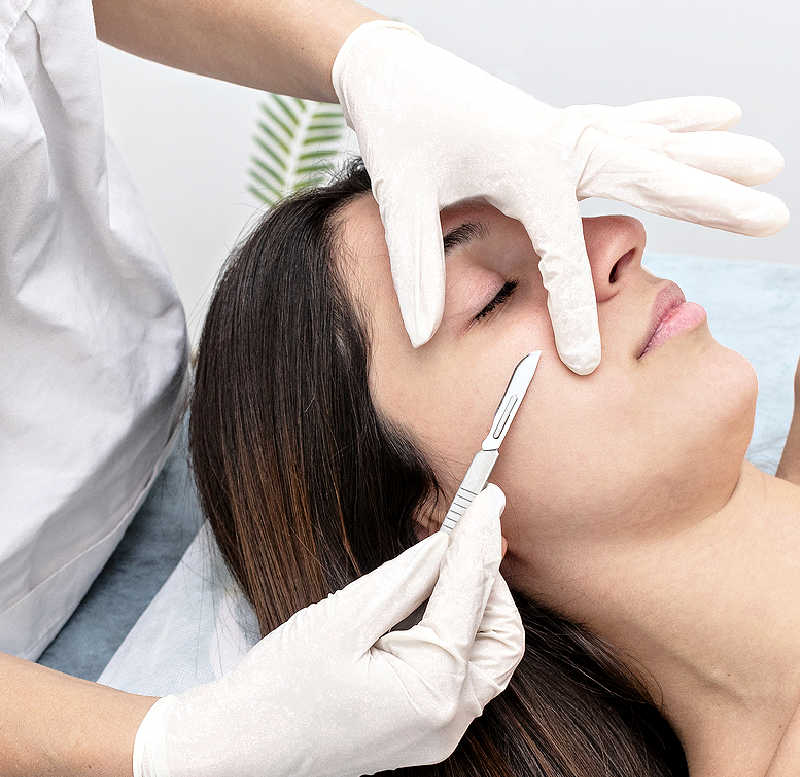As an Amazon Associate, I earn from qualifying purchases and other affiliate links. I only recommend products I’ve tried or researched.
- Home
- Skincare Guide
- Exfoliation Guide
- Dermaplaning
Pros and Cons to Dermaplaning
Pros and Cons to Dermaplaning: Learn about the advantages and disadvantages of in-office and at-home options, so you can make an educated decision for your skin.

Are you always trying to get that perfect, shiny skin? Then you’ve probably come across a few articles and videos promoting the practice of dermaplaning.
Known to renew your skin by gently scraping off the top layer of dead skin and tiny hairs, dermaplaning leaves your skin looking noticeably fresher and brighter.
Different dermaplaning approaches exist, each with its own pros and cons.
Here, we'll break down the benefits and disadvantages associated with professional treatments at skincare clinics and do-it-yourself (DIY) kits for home use.
The Beauty of Dermplaning – The Pros
Whether you choose a professional or a DIY approach, dermaplaning offers some attractive advantages.
Let's look at the pros of professional dermaplaning and at home treatments.
Professional in-office dermaplaning

Expertise
A trained esthetician performs the procedure. They know exactly how to handle the blade and the particular angle to ensure maximum results.
Tailored treatment
What are your goals for dermaplaning? Are you concerned about scars, hyperpigmentation, fine lines or dull skin? A professional can assess your needs and give you a customized treatment.
Advanced Tools
Professional dermaplaning tools are designed to work deeper than at-home tools due to sharper blades which provide a more thorough exfoliation.
Improved Absorption
Deep exfoliation enhances how well your skincare products work, so they can do their magic.
Safety
With a professional, you have greater assurance that potential accidents or errors will be greatly minimized as opposed to doing it at home.
Possible Skin Improvement
- Noticeable degree of smoothness and radiance due to removal of facial hair and multiple layers of dead cells.
- Increase absorption of skincare products and smoother makeup application.
- Increases collagen production due to the intensive exfoliation.
- Reduced visibility in the appearance of scars, lines, and wrinkles.
- Even skin tone due to the deeper level of exfoliation.
- Post-procedure advice and care provided by professionals is an added benefit.
At-home dermaplaning

I’ve been dermaplaning at home for years, and it’s my go-to for a quick skin refresh. Plus, getting rid of that peach fuzz leaves my complexion so much smoother!
Here are a few other reasons to consider DIY dermaplaning...
Budget Friendly
At-home blades are inexpensive and are available for purchase online or at local stores. You can get a pack of 3 blades for less than $6 on Amazon.
Flexibility
You can do it at your own convenience, without having to schedule appointments or travel.
Frequency
You can use at-home dermaplaning tools regularly, adjusting the frequency to suit your skincare routine.
Control
You have full control over the treatment process, allowing you to target specific areas or focus on areas of concern.
Maintain Results
Regular use of at-home dermaplaning tools can help maintain the results achieved through professional treatments.
Customization
You can choose the specific at-home dermaplaning tool that suits your needs and preferences.
Possible Skin Improvement
- Smoother skin due to removal of surface-level dead skin cells and peach fuzz.
- Better makeup application and absorption of skincare products.
- Brighter complexion to a certain extent by getting rid of dullness caused by dead skin cells.
- Reduced visibility of fine lines to some degree.
Understanding the Caveats - The Cons
As essential as understanding the benefits of dermaplaning, it is also equally important to look into the potential downsides.
Let's look at the cons of both types of treatments.
Professional in-office dermaplaning
Cost
At $75-$150, cost is big drawback when considering professional dermaplaning. With optimal results requiring frequent visits, these expenses can quickly add up.
Time
In addition to the cost of the procedure, you’ll have to commit the time to attend the appointment, which can be up to an hour or more.
Potential side-effects
Even though it is done by a professional, it is a more intense treatment. As a result, some people may experience side effects like redness, irritation, minor scratches or breakouts, especially if they have sensitive skin.
At-home dermaplaning
User Technique
Home dermaplaning tools usually come with instructions, but it can take a few tries to master the technique. A learning curve is involved, and mistakes during early attempts could lead to skin irritation.
Less Effective
The results might not be as dramatic or long-lasting as a professional job, since the home kits are not as potent or deep-penetrating as professional-grade tools.
Risk of Over-exfoliation
Without the professional oversight, one might over-exfoliate, removing too much of the skin's protective barrier and leading to sensitivity, irritation, and even premature aging.
Safety
If the tools are not properly cleaned or used, they can introduce bacteria into the skin, causing irritation or breakouts.
Choosing the Wrong Tool
One advantage of at-home treatment is the extensive selection of tools available. However, from personal experience, this wide range of choices can also pose a downside for home dermaplaning.
Choosing the right tool can often be a trial-and-error process, as using blades that are too sharp or too large may be difficult to handle and could result in cuts or irritation.
Note: If you're new to dermaplaning, you might want to star with the cheaper, smaller blades. Based on my personal experience, I've found them to be easier to use and not as sharp, making them ideal for beginners like me. As you gain confidence, you can consider the pricier options.
How does it compare to other skin treatments
Compared to other exfoliation treatments like microdermabrasion, chemical peels, and laser therapy, dermaplaning (in-office and DIY) is gentler.
It avoids chemicals and requires minimal downtime, making it a convenient choice for many.
However, for severe skin concerns like scars and age spots, treatments like chemical peels and laser therapy may be more effective, reaching deeper layers and addressing more advanced issues.
Each treatment has its own advantages and disadvantages, so it's crucial to consider how they impact your skin to make an informed decision.
Consulting a dermatologist or skincare expert is advisable to ensure a safe and effective choice based on your unique skin type and health history.
Final thought: Pros and cons to dermaplaning
Assessing the pros and cons of a dermaplane facial done by a professional compared to doing it at home can be a bit tricky.
When you get it done professionally, you see more obvious results, especially if you have specific skin issues like scars or dark spots.
Here's a suggestion: Consider having a series of professional treatments once or twice a year, then use at-home treatments to maintain the results. It's like a combination approach that can work wonders for your skin.
It's essential to take all these factors into account and, if you're unsure about what's best for your complexion, consider discussing it with a trusted dermatologist.
The skincare world offers plenty of options, and dermaplaning can be a game-changer. However, like any skincare routine, it's wise to weigh the pros and cons before diving in.
Want More?
I share quick routines, beauty tweaks, and what’s working for me — straight to your inbox. Join the Club and get this free Cheek Shaper Video.
About the Author:
Linda Robison is a Facial Fitness Specialist and the founder of Anti-Aging Beauty Zone. With decades of hands-on experience, she shares practical, natural ways to lift and brighten mature skin—without expensive or invasive treatments.
Before you go ....
Please tap on the💙in the bottom right corner if you found this page helpful.
FOLLOW ME FOR MORE TIPS:
SHARE OR SAVE FOR LATER:




